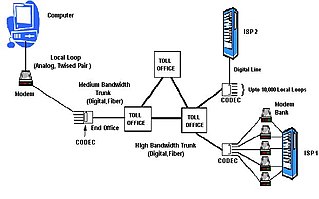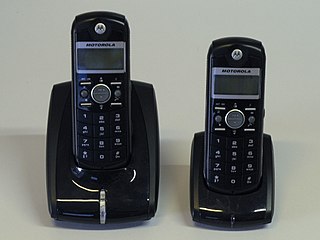Related Research Articles
In telecommunications, a customer-premises equipment or customer-provided equipment (CPE) is any terminal and associated equipment located at a subscriber's premises and connected with a carrier's telecommunication circuit at the demarcation point ("demarc"). The demarc is a point established in a building or complex to separate customer equipment from the equipment located in either the distribution infrastructure or central office of the communications service provider.
Digital subscriber line is a family of technologies that are used to transmit digital data over telephone lines. In telecommunications marketing, the term DSL is widely understood to mean asymmetric digital subscriber line (ADSL), the most commonly installed DSL technology, for Internet access.

In telecommunications, a network interface device is a device that serves as the demarcation point between the carrier's local loop and the customer's premises wiring. Outdoor telephone NIDs also provide the subscriber with access to the station wiring and serve as a convenient test point for verification of loop integrity and of the subscriber's inside wiring.
Telephony is the field of technology involving the development, application, and deployment of telecommunication services for the purpose of electronic transmission of voice, fax, or data, between distant parties. The history of telephony is intimately linked to the invention and development of the telephone.

In telephony, the local loop is the physical link or circuit that connects from the demarcation point of the customer premises to the edge of the common carrier or telecommunications service provider's network.
Voice over Internet Protocol (VoIP), also called IP telephony, is a method and group of technologies for voice calls for the delivery of voice communication sessions over Internet Protocol (IP) networks, such as the Internet.
Plain old telephone service (POTS), or plain ordinary telephone system, is a retronym for voice-grade telephone service employing analog signal transmission over copper loops. POTS was the standard service offering from telephone companies from 1876 until 1988 in the United States when the Integrated Services Digital Network (ISDN) Basic Rate Interface (BRI) was introduced, followed by cellular telephone systems, and voice over IP (VoIP). POTS remains the basic form of residential and small business service connection to the telephone network in many parts of the world. The term reflects the technology that has been available since the introduction of the public telephone system in the late 19th century, in a form mostly unchanged despite the introduction of Touch-Tone dialing, electronic telephone exchanges and fiber-optic communication into the public switched telephone network (PSTN).

A digital subscriber line access multiplexer is a network device, often located in telephone exchanges, that connects multiple customer digital subscriber line (DSL) interfaces to a high-speed digital communications channel using multiplexing techniques. Its cable internet (DOCSIS) counterpart is the cable modem termination system.
The public switched telephone network (PSTN) is the aggregate of the world's telephone networks that are operated by national, regional, or local telephony operators. It provides infrastructure and services for public telephony. The PSTN consists of telephone lines, fiber-optic cables, microwave transmission links, cellular networks, communications satellites, and undersea telephone cables interconnected by switching centers, such as central offices, network tandems, and international gateways, which allow telephone users to communicate with each other.
A leased line is a private telecommunications circuit between two or more locations provided according to a commercial contract. It is sometimes also known as a private circuit, and as a data line in the UK. Typically, leased lines are used by businesses to connect geographically distant offices.

A cordless telephone or portable telephone has a portable telephone handset that connects by radio to a base station connected to the public telephone network. The operational range is limited, usually to the same building or within some short distance from the base station.

A business telephone system is a telephone system typically used in business environments, encompassing the range of technology from the key telephone system (KTS) to the private branch exchange (PBX).

A security alarm is a system designed to detect intrusions, such as unauthorized entry, into a building or other areas, such as a home or school. Security alarms protect against burglary (theft) or property damage, as well as against intruders. Examples include personal systems, neighborhood security alerts, car alarms, and prison alarms.
Cable telephony is a form of digital telephony over cable TV type networks. A telephone interface installed at the customer's premises converts analog signals from the customer's in-home wiring to a digital signal, which is then sent over the cable connection to the company's Cable television headend switching center. The signal is then sent on to the public switched telephone network (PSTN). Cable telephone provides another revenue stream for cable television system operators and gives the consumer the convenience of a single bill for combined television, internet and telephone services.
Direct inward dialing (DID), also called direct dial-in (DDI) in Europe and Oceania, is a telecommunication service offered by telephone companies to subscribers who operate private branch exchange (PBX) systems. The feature provides service for multiple telephone numbers over one or more analog or digital physical circuits to the PBX, and transmits the dialed telephone number to the PBX so that a PBX extension is directly accessible for an outside caller, possibly by-passing an auto-attendant.

A VoIP phone or IP phone uses voice over IP technologies for placing and transmitting telephone calls over an IP network, such as the Internet. This is in contrast to a standard phone which uses the traditional public switched telephone network (PSTN).

A fire alarm system is a building system designed to detect, alert occupants, and alert emergency forces of the presence of fire, smoke, carbon monoxide, or other fire-related emergencies. Fire alarm systems are required in most commercial buildings. They may include smoke detectors, heat detectors, and manual fire alarm activation devices. All components of a fire alarm system are connected to a fire alarm control panel. Fire alarm control panels are usually found in an electrical or panel room. Fire alarm systems generally use visual and audio signalization to warn the occupants of the building. Some fire alarm systems may also disable elevators, which are unsafe to use during a fire under most circumstances.

H.323 is a recommendation from the ITU Telecommunication Standardization Sector (ITU-T) that defines the protocols to provide audio-visual communication sessions on any packet network. The H.323 standard addresses call signaling and control, multimedia transport and control, and bandwidth control for point-to-point and multi-point conferences.
BT Redcare is the largest supplier of alarm signalling services for security and fire in the UK. It was established over thirty years ago, and works with both the business and domestic markets.
As in many other countries, the United Kingdom is retiring its part of the global circuit-switched public switched telephone network.
References
- 1 2 NFPA (2009). National Fire Alarm and Signaling Code, NFPA 72, 2010 edition. National Fire Protection Association. pp. 26–3.3.141, 164 – A.3.3.141. ISBN 978-0-06-464133-3.
- ↑ Hansell, Saul (17 September 2009). "Verizon Boss Hangs Up on Landline Phone Business". Business, Innovation, Technology, Society. The New York Times.
- ↑ "Comments - NBP Public Notice #25; Comments of AT&T Inc. on the Transition from the Legacy Circuit-Switched Network to Broadband" (PDF). Federal Communications Commission. 21 December 2009.
- ↑ NFPA (2009). "NFPA 72, TIA 10-3" (PDF).
- ↑ Florida Division of State Fire Marshal, Florida Administrative Code (F.A.C.), Monitoring section of the FIRE SAFETY STANDARDS FOR FIRE ALARM SYSTEMS Rule Number 69A-48.008, ID 7860509